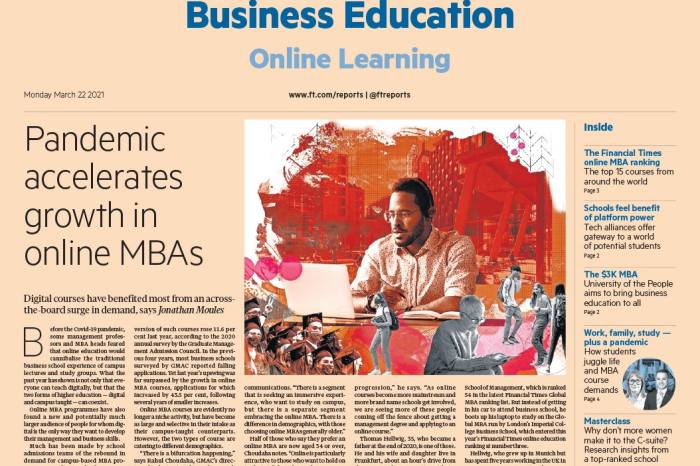Digital platforms give business schools global reach
Disruption is the objective of many know-how commence-ups. But, in the training sector, a range of tech ventures are building businesses dependent on encouraging — instead than competing with — universities and universities.
These on line training platforms — these as Coursera, 2U, Udacity and FutureLearn — originally began out with utopian visions of no cost understanding by way of bite-sized tutorials, recognised as significant open on line programs (Moocs). Some Moocs proved massively common, but significant dropout rates and the issues of monetising this understanding convinced the platforms to variety partnerships with universities instead, to run paid-for programs with them on line, and share the earnings.
As a company product, it had been attaining traction before the coronavirus pandemic strike. Even so, the lockdown of campuses and people’s need to retrain through a time of turbulence in the employment market place has pushed up applications substantially in the earlier 12 months.
Among the attractions of these on line training platforms is their skill to provide students close to the globe, which has encouraged some company universities to go all out with a electronic technique.
Gies School of Small business, component of the College of Illinois at Urbana-Champaign, partnered with the Silicon Valley-dependent Coursera in 2016 to give an completely on line MBA programme — winding down its campus-dependent MBA course in the system. Its iMBA now has practically 4,000 students, up from an consumption of 114 in its initially year. Every pays just below $22,000 in tuition service fees — considerably considerably less than the 6-figure sums essential for the maximum-ranked campus-dependent MBA programmes but extra than other on line MBAs.
![Brooke Elliott, associate dean at Gies College: ‘[Coursera] want to scale and so do we’](https://www.ft.com/__origami/service/image/v2/images/raw/https%3A%2F%2Fd1e00ek4ebabms.cloudfront.net%2Fproduction%2Feb12dfd9-977c-49a4-b1e4-15978d79e45c.jpg?fit=scale-down&source=next&width=200)
Coursera is enabling the college to achieve nations around the world and candidates it could by no means have obtained to by way of its individual promoting efforts, in accordance to Brooke Elliott, affiliate dean at Gies.
“Our objectives were aligned with Coursera because they want to scale and so do we — in our case, to reach our mission as a community college of furnishing the broadest obtain to training,” she says. A further more profit, Elliott adds, is that Coursera’s worldwide community of learners and company associates gives insights into what Gies should really be instructing.
While alliances with on line platforms have enabled universities to conserve revenue on establishing in-dwelling electronic instructing instruments, Elliott says Gies has had to make a sizeable expense in on line understanding alone. This has been required to make the content material — by building four generation studios and employing a 39-man or woman “e-learning” group to acquire course materials — and to keep all the intellectual house in the instructing.
World wide viewers
Rival system FutureLearn has also been capitalising on the change to on line understanding. Launched in 2012 by the UK’s Open College, it now has partnerships with extra than a quarter of the world’s top rated bigger training institutes and company universities.
When it signed the initially of these, in 2015, administration and company programs were the third most common course category on the system. Now, they are range just one.
“We assist our associates achieve audiences and markets that perhaps they can not on their individual,” says Justin Cooke, FutureLearn’s chief content material and partnerships officer, noting that the platform’s company and administration programs entice extra girls than adult men, in contrast to most primary MBA programs.

See the comprehensive 2021 Monetary Occasions On the net MBA listing as effectively as the complete report on Monday March 22
“We are a market with 15m learners from each and every nation in the environment,” Cooke says. “Even a environment-class company college is not achieving that measurement of viewers.”
But while company universities have been brief to embrace system tie-ups, they are also mindful that their campus-dependent instructing models have loads of everyday living in them nonetheless.
HEC Paris began instructing a fully on line MSc in innovation and entrepreneurship applying Coursera in 2017. Its affiliate dean of executive training, Anne-Valérie Corboz, says: “The crucial point for us is to build partnerships outside our campus partitions.” Even so, while she praises the “flexibility and adaptability” of the on line product, she adds: “Online training is not economic downturn evidence and it will not replace our instructing offline.”
Buyers wished
In fact, for all the expansion in on line understanding, the system product has however to verify alone. Individual platforms carry on to compete with just about every other to indication up instructional institutions, and arise as a “winning brand” in a market place that appears to be like ripe for consolidation.
Some believe that expense will be crucial. This thirty day period, Coursera announced a system to increase up to $100m by way of an initial community giving on the New York Stock Exchange. Launched in 2012 by two Stanford computer system science professors, it now boasts extra than 77m registered learners and 200 associates throughout bigger training and market.
But not all of its buyers decide on to pursue — and shell out for — diploma certification soon after consuming no cost course content material, which leaves Coursera with a blended story to convey to buyers. In 2020, sales rose fifty nine for each cent to $293.5m year-on-year, but losses also grew by forty three for each cent around the same interval to about $sixty six.8m — and the business said it would carry on to put up losses for the foreseeable future. FutureLearn is also lossmaking and has not set a day for turning financially rewarding, Cooke says.
None of this is unusual for an on line expansion company. It is, even so, a indication of how a lot revenue might be required to make on line training — as a company product — get the job done out.







